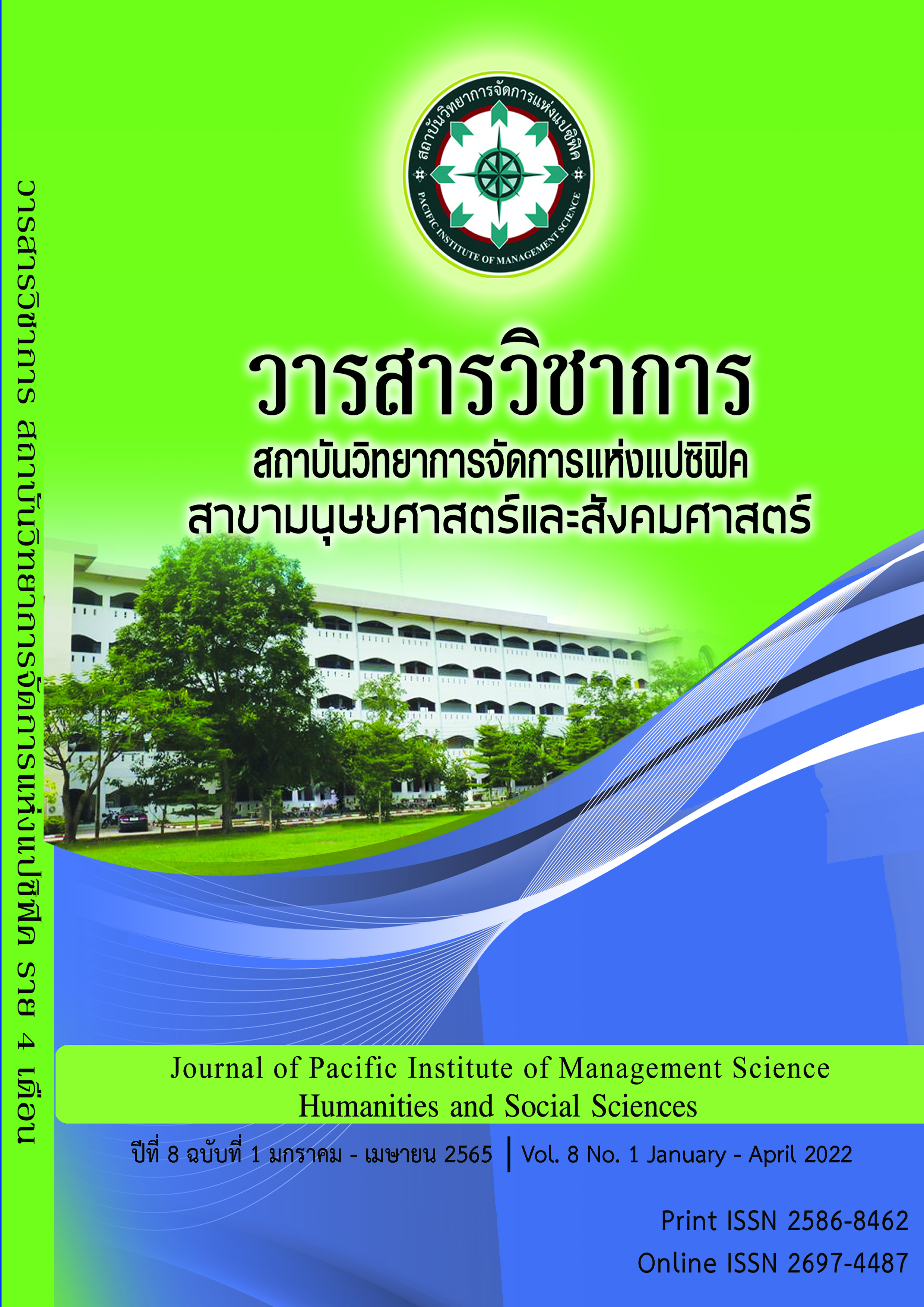The development of student support system model for Subsomboon Pittayalai School under Khon Kaen Provincial Administrative Organization
Keywords:
The Development of Model, the student support system model, empowerment evaluationAbstract
The development of student support system model for Subsomboon Pittayalai School under Khon Kaen Provincial Administrative Organization aimed 1) to study the situations of student support system implementation and the need of self- development of educational personnel in the aspect of student support system implementation, 2) to develop the student support system, 3)to try out the student support system. The samples for phase were 102 personnel involved in educational management of Sub Somboon Pittayalai School. The data collection was performed using inquiries, interviews, and document analysis, participant observation and data recording. The quantitative data analysis used descriptive statistics including frequency distribution, percentage, mean, standard deviation, median, inter-quartile range. The inferential statistic was t-test, and the qualitative data segment used content analysis.
The research results were as follows:
Part 1 The situations of student support system of Sub Somboon Pittayalai School
The results of data analysis concluded that the basic principles of the student support system in the aspect of process consisted of three dimensions, i.e., attributes or criteria to be evaluated dimensions, characteristics or procedures for student support system dimensions, and empowerment evaluation procedure dimensions. The study results of the student support system situations showed that the student support system situations in continuous implementation of Sub Somboon Pittayalai School knew the student individually at the highest level, and there were the details to be evaluated and the lowest comprehensive assessment dimensions are specified. The details to be assessed and the assessment dimensions were at the lowest level.
Part 2 The development of student support system
The structural suitability results of the five main elements and sub-elements were appropriate at the highest level, and the opinions of experts were consistent. Considering in the sub-elements, it was found that the suitability, possibility, clarity and ease of use were at the high to highest levels That all experts had consistent opinions on all issues.
Part 3 Trial of the student support system model according to empowerment evaluation, it was found that:
3.1 Knowledge and understanding of the student support system before and after the trial showed that the personnel revealed knowledge and understanding about the student support system after the development significantly higher than before development at the .05 level.
3.2 Attitude towards the student support system before and after the trial,
it was found that the participants had attitudes towards the student support system significantly higher than before development at the .05 level.
References
กรมวิชาการ. (2545). เอกสารระบบดูแลช่วยเหลือนักเรียน ในโรงเรียนสังกัดกรมสามัญศึกษาฉบับ
เจริญ ภักดีวานิช. (2546). งานวิชาการเป็นหัวใจของการปฏิรูปการศึกษา. วิทยานิพนธ์ :มหาวิทยาลัยศิลปากร.
เดชา สารมานิตย์. (2556). การพัฒนาการดำเนินงานระบบดูแลช่วยเหลือนักเรียนโรงเรียนบ้านนาสีนวลสำนักงานเขตพื้นที่การศึกษาประถมศึกษาสกลนคร เขต 2. การศึกษาค้นคว้าอิสระ กศ.ม. มหาสารคาม : มหาวิทยาลัยมหาสารคาม.
ชนม์ชกรณ์ วรอินทร์. (2549). การพัฒนารูปแบบการประกันคุณภาพภายในสถานศึกษาระดับการผู้บริหาร. กรุงเทพฯ : คุรุสภาลาดพร้าว,.ศึกษาขั้นพื้นฐาน : การประเมินแบบเสริมพลัง. ดุษฎีนิพนธ์ มหาวิทยาลัยศรีนครินทรวิโรฒ.
เดชา สารมานิตย์. (2556). การพัฒนาการดำเนินงานระบบดูแลช่วยเหลือนักเรียนโรงเรียนบ้านนาสีนวล สำนักงานเขตพื้นที่การศึกษาประถมศึกษาสกลนคร เขต 2. การศึกษาค้นคว้าอิสระ กศ.ม. มหาสารคาม : มหาวิทยาลัยมหาสารคาม.
เทวาฤทธิ์ ผุยวันดี. (2554). ปัญหาและแนวทางการพัฒนาการดำเนินงานระบบดูแลช่วยเหลือนักเรียนของโรงเรียนบ้านคลองสิบสาม สังกัดสำนักงานเขตพื้นที่การศึกษาสระแก้ว เขต 1 . เข้าถึงเมื่อ 25 พฤศจิกายน 2560. เข้าถึงได้จาก htt://www.school.obec.go.th/tanonnoi/doc/opaso2.doc.
นิรันดร์ จำปาเจียม. (2560). แนวทางการพัฒนาระบบดูแลช่วยเหลือนักเรียนโรงเรียนสักสันเชียงใหม่วิทยาคม สำนักงานเขตพื้นที่การศึกษาประถมศึกษาเชียงราย เขต 4. เข้าถึงเมื่อ 14 พฤศจิกายน. เข้าถึงได้ จาก htt://www.kroobannok.com/.
ผ่องศรี แก้วชูเสน และคณะ. (ไม่ปรากฏปี พ.ศ.). การพัฒนารูปแบบการประกันคุณภาพภายในสถานศึกษา โดยใช้การประเมินแบบเสริมพลัง สำหรับวิทยาลัยเกษตรและเทคโนโลยี. เข้าถึงเมื่อ 20 พฤศจิกายน. เข้าถึงได้จากhtt://www.yru.ac.th/e-journal/file/pongsee/old_184.doc.
มณีรัตนา โนนหัวรอ. (2557). การพัฒนารูปแบบการประเมินแบบเสริมพลังอำนาจเพื่อเพิ่มสมรรถนะด้านการวัดและประเมินผลการศึกษาของครูประจำการ สังกัดสำนักงานเขตพื้นที่การศึกษาประถมศึกษาปราจีนบุรี เขต 2. ปริญญานิพนธ์ (กศ.ด.) บัณฑิตวิทยาลัย. มหาวิทยาศรีนครินทรวิโรฒ.
วีระพงษ์ วันทา. (2555). ผลการดำเนินงานระบบดูแลช่วยเหลือนักเรียนของข้าราชการครูในสถานศึกษา สังกัดสำนักงานเขตพื้นที่การศึกษามัธยมศึกษาเขต 29 (อุบลราชธานี – อำนาจเจริญ). วิทยานิพนธ์ ครุศาสตรมหาบัณฑิต : มหาวิทยาลัยราชภัฏอุบลราชธานี.
ศิริชัย กาญจนวาสี. (2547). ทฤษฎีการประเมิน. พิมพ์ครั้งที่ 4. กรุงเทพฯ : โรงพิมพ์แห่งจุฬาลงกรณ์มหาวิทยาลัย.
สาธิดา สกุลรัตนกุลชัย. (2554). การประเมินแบบเสริมพลังในการเรียนการสอนแบบสตูดิโอทางสถาปัตยกรรม. SDU Research Journal, 7(2): 143-151. กรรมการวิจัยแห่งชาติ.
สุนันท์ โพธิบาย. (2555). การประเมินผลระบบดูแลช่วยเหลือนักเรียนในโรงเรียนขยายโอกาสทางการศึกษาสังกัดสำนักงานเขตพื้นที่การศึกษาหนองบัวลำภู เขต 1. การศึกษาค้นคว้าอิสระ กศ.ม. มหาสารคาม : มหาวิทยาลัยมหาสารคาม.
สํานักงานคณะกรรมการการศึกษาขั้นพื้นฐาน กระทรวงศึกษาธิการ. (2554). แนวทางการบริหารจัดการเรียนรู้สู่ประชาคมอาเซียน.กรุงเทพฯ : โรงพิมพ์ชุมชนสหกรณ์การเกษตรแห่งประเทศไทยจํากัด.
สำนักงานคณะกรรมการการศึกษาแห่งชาติ. (2543). พระราชบัญญัติการศึกษาแห่งชาติ พ.ศ. 2542. กรุงเทพฯ : พริกหวาน กราฟฟิค จำกัด.
อวยชัย ศรีตระกูล. (2556). การพัฒนารูปแบบการบริหารระบบการดูแลช่วยเหลือนักเรียนในสถานศึกษาสังกัดสำนักงานเขตพื้นที่การศึกษาประถม. ปริญญาการศึกษาดุษฎีบัณฑิต มหาวิทยาลัยนเรศวร.
Fetterman, D.M. (1994). Empowerment Evaluation. Evaluation Practice, 15(1) : 1–15.
Downloads
Published
Issue
Section
License
Copyright (c) 2022 Pacific Institute of Management Science

This work is licensed under a Creative Commons Attribution-NonCommercial-NoDerivatives 4.0 International License.
บทความที่ได้รับการตีพิมพ์เป็นลิขสิทธิ์ของ สถาบันวิทยาการจัดการแห่งแปซิฟิค
ข้อความที่ปรากฏในบทความแต่ละเรื่องในวารสารวิชาการเล่มนี้เป็นความคิดเห็นส่วนตัวของผู้เขียนแต่ละท่านไม่เกี่ยวข้องกับสถาบันวิทยาการจัดการแห่งแปซิฟิค และคณาจารย์ท่านอื่นๆในสถาบันฯ แต่อย่างใด ความรับผิดชอบองค์ประกอบทั้งหมดของบทความแต่ละเรื่องเป็นของผู้เขียนแต่ละท่าน หากมีความผิดพลาดใดๆ ผู้เขียนแต่ละท่านจะรับผิดชอบบทความของตนเองแต่ผู้เดียว







